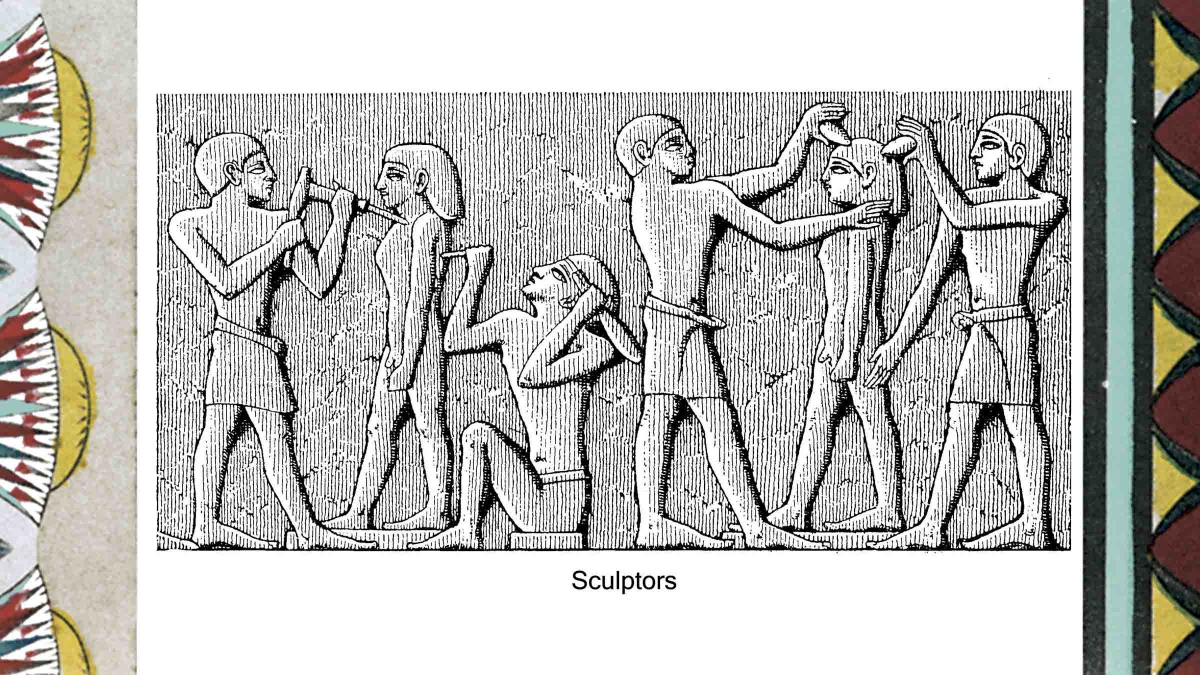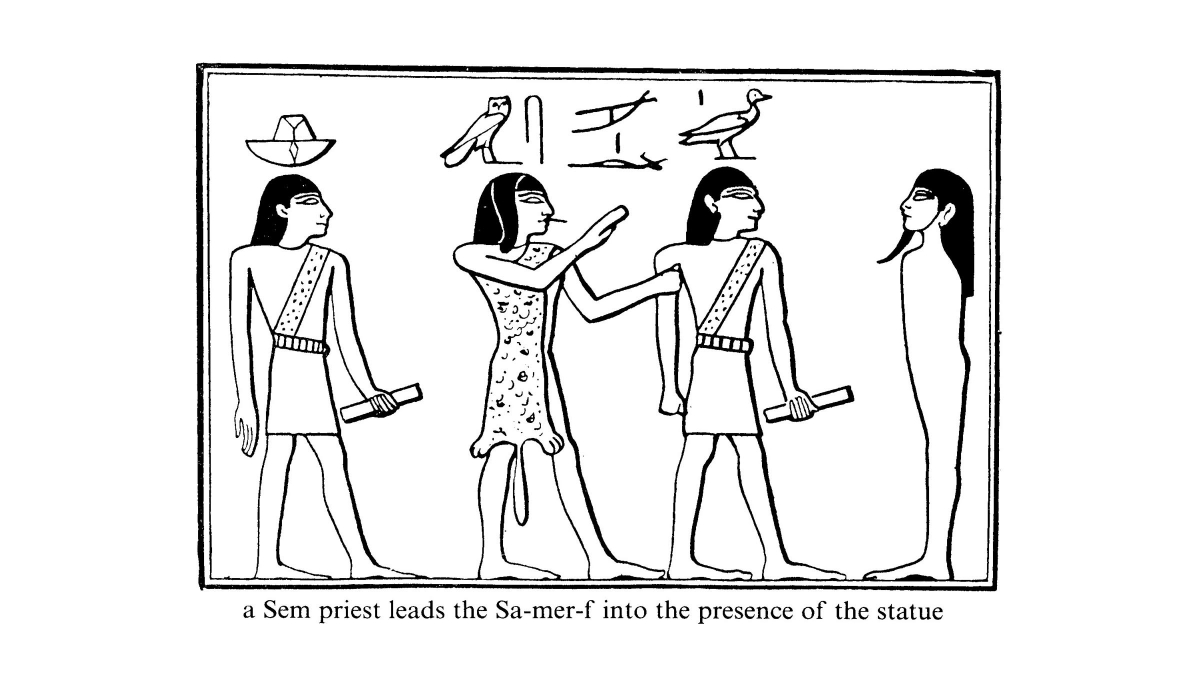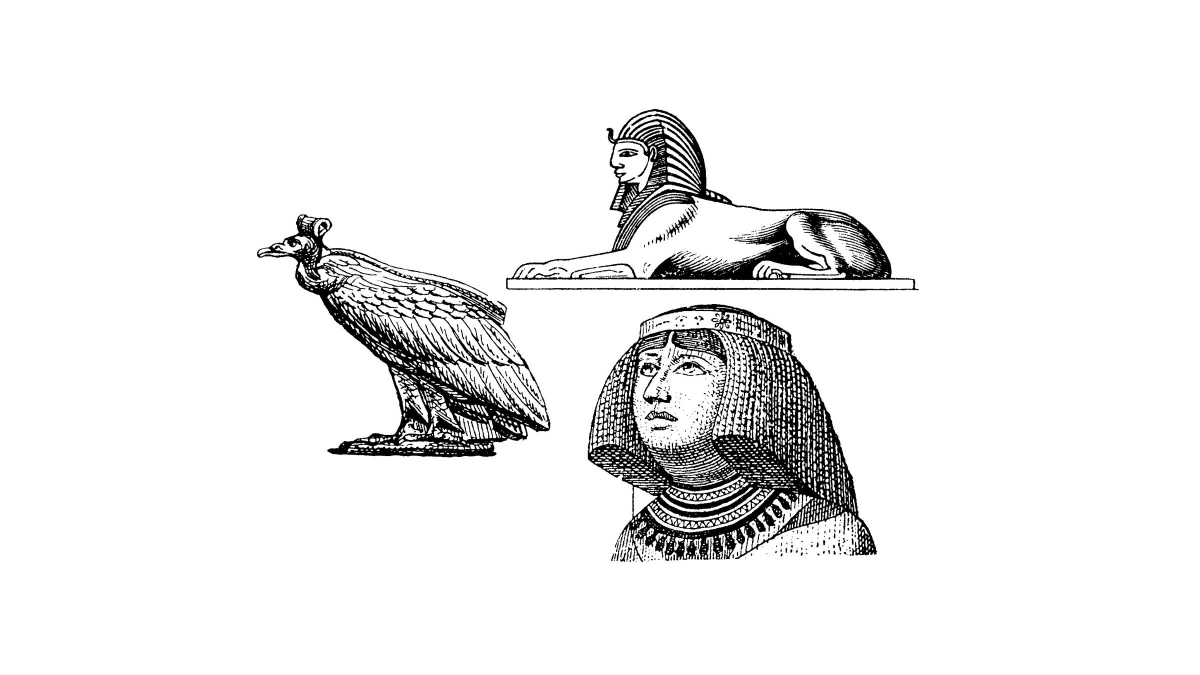Artists and Sculptors
Why did Ancient Egyptians draw and sculpt that way? They did not have a word that corresponds to our word 'art'. They do not seem to have made statues or paintings to collect or to hang on the walls of museums and art galleries. But they loved to be surrounded by beauty in life and in death. Their homes often had paintings on the walls, and royal palaces had elaborately painted floors and ceilings. Tombs were filled with as many statues, and as much carving and painting, as the owner could afford.
It may seem strange to think that some of the most beautiful images we have of Ancient Egypt in fact come from tombs, and would have seldom or never been seen by living people. Why would anyone go to the trouble of making fine statues of himself or herself, and then bury these where no one could see them?

Egyptian statues, wall paintings and carved stele were all functional. The images we see of humans and gods, animals and plants, had a religious intention. They were almost always part of the cult of a god or of the dead. Statues were places where gods or deceased humans could manifest themselves, places where a spirit could dwell. For non-royal people, the images in the tombs were places of contact between the world of the dead and the world of the living. The spirit of the dead could enter into an image and thus be aware of, and partake of the food offerings left by the living.
Images of battles, of hunting, of farming or family life, beautifully carved into the walls of temples and tombs, ensured that these things would continue forever. Scenes of religious rituals on the walls of temples meant that, even if for some reason the king or the priests could not perform the holy rites of the gods, these essential actions would still go on.
Since the making of images was so important to Ancient Egyptian society, artists and craftsmen were often privileged persons, enjoying a much higher standard of living than farmers or craftsmen such as potters.
As far as we know, most of the Ancient images we see were made by men. Boys would become their father's apprentices, and gradually learn their father's craft and art. As in any society, there were highly skilled craftsmen, and those who were not quite as good. When we visit Museums and Art Galleries, and look into books on Egyptian Art, we tend to see the work of the most skillful, paid for by the richest members of society. It's important to remember, though, that less wealthy people also commissioned statues and carvings. This work may be less appealing to us, less 'beautiful' but it was just a functional, just as useful to the owner, as the most wonderful statues made for kings and royal wives.

The Ancient Egyptian craftsmen knew their materials very well. Most statues were made in limestone, a materials that is slightly softer and easier to carve when freshly cut, and which hardens on exposure to air. White limestone statues and wall carvings also take paint well, and often statues survive from four thousand years ago, almost as fresh and bright as the day they were painted.
Paints were made from mineral pigments, and this is why they have lasted so well.
Black was made from carbon, sometimes from soot scraped from cooking vessels. This material is often called lamp black. Powdered charcoal was also used for black, and occasionally an ore of manganese from the Sinai was used, though this was rare.
Blue could be made from a ground up mineral, azurite, an ore of copper. The usual blue, though, was an artificially created material, called Egyptian Blue. It was a compound of silica, copper, and calcium. The three materials were ground together (the copper in the form of malachite) and heated with a mixture of calcium carbonate and natron, a form of soda. This frit would have much more expensive to produce than colours made from a single mineral. Though one sometimes reads that lapis lazuli was powered to make ultramarine blue, or that turquoise was ground up to make pigment, there is no evidence as yet that these substances were used. Both turquoise and lapis would have been expensive stones in Ancient Egypt, and used for jewellery.
Brown was usually an ochre or iron oxide. Sometimes brown was made by painting red over black. Brown ochre does occur in nature, in the Dakhla Oasis, and could have been imported from there by artists.
The usual green of the Ancient Egyptians was malachite, an ore of copper. Sometimes an artificial frit, similar to the blue, was made. Malachite, ground to powder, was also used for eye shadow.
Orange was usually made by painting red over yellow, or mixing red and yellow ochres.
Pink was seldom used in the Age of the Pyramids, but was more popular in the New Kingdom. It seems to have been made by mixing red ochre and white gypsum.

There are many natural iron oxides that produce red colours. Red iron oxides (anhydrous oxides) and red ochres (hydrated oxides of iron) are both used. These materials occur as amorphous earths. Hematite, a beautiful metallic ore of iron, was not ground up for pigment, but was used for beads, kohl sticks, scarabs, and other small objects.
White may have been calcium carbonate (chalk) or calcium sulphate (gypsum). Both of these natural materials are plentiful in Egypt.
At least two different yellow pigments were used. The most common is yellow ochre, a naturally occurring ore of iron. The other is orpiment, a natural sulphide of arsenic. Orpiment does not seem to have been used in the Age of the Pyramids, but came into use in the New Kingdom. Other yellows were sometimes used, such as massicot, a yellow oxide of lead. Ochre with plant materials added to make a more intense yellow also occurs.
Paint brushes were made of natural fibres, and come in many sizes, from those used to white-wash whole walls, to fine brushes for detail.
Ancient Egyptian art often looks uniform. The people all seem to 'walk like Egyptians' and the image of a row of seated or standing or walking Egyptians is common. Part of this uniformity is due to the use of lines and grids by the artists, to help them to line up images. If you look carefully, you will see that knees, shoulders, and heads usually line up in Egyptian paintings. This gives a pleasing harmony.
